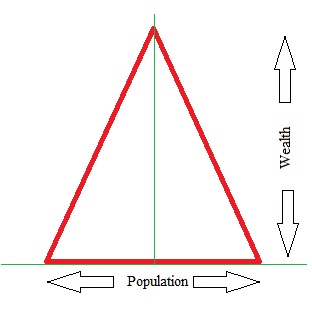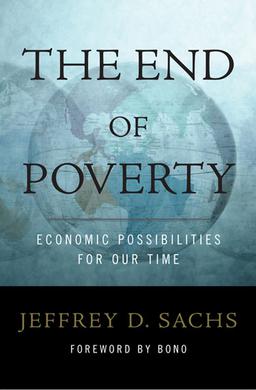
Extreme poverty is the most severe type of poverty, defined by the United Nations (UN) as "a condition characterized by severe deprivation of basic human needs, including food, safe drinking water, sanitation facilities, health, shelter, education and information. It depends not only on income but also on access to services". Historically, other definitions have been proposed within the United Nations.

Poverty is a state or condition in which one lacks the financial resources and essentials for a certain standard of living. Poverty can have diverse social, economic, and political causes and effects. When evaluating poverty in statistics or economics there are two main measures: absolute poverty compares income against the amount needed to meet basic personal needs, such as food, clothing, and shelter; relative poverty measures when a person cannot meet a minimum level of living standards, compared to others in the same time and place. The definition of relative poverty varies from one country to another, or from one society to another.

International development or global development is a broad concept denoting the idea that societies and countries have differing levels of economic or human development on an international scale. It is the basis for international classifications such as developed country, developing country and least developed country, and for a field of practice and research that in various ways engages with international development processes. There are, however, many schools of thought and conventions regarding which are the exact features constituting the "development" of a country.

WaterAid is an international non-governmental organization, focused on water, sanitation and hygiene. It was set up in 1981 as a response to the UN International Drinking Water decade (1981–1990). As of 2018, it was operating in 34 countries.

The Millennium Development Goals (MDGs) were eight international development goals for the year 2015 that had been established following the Millennium Summit of the United Nations in 2000, following the adoption of the United Nations Millennium Declaration. These were based on the OECD DAC International Development Goals agreed by Development Ministers in the "Shaping the 21st Century Strategy". The Sustainable Development Goals (SDGs) succeeded the MDGs in 2016.

In international relations, aid is – from the perspective of governments – a voluntary transfer of resources from one country to another.

Poverty reduction, poverty relief, or poverty alleviation, is a set of measures, both economic and humanitarian, that are intended to permanently lift people out of poverty.

The bottom of the pyramid, bottom of the wealth pyramid, bottom of the income pyramid or the base of the pyramid is the largest, but poorest socio-economic group. In global terms, this is the 2.7 billion people who live on less than $2.50 a day.

International inequality refers to inequality between countries, as compared to global inequality, which is inequality between people across countries. International inequality research has primarily been concentrated on the rise of international income inequality, but other aspects include educational and health inequality, as well as differences in medical access. Reducing inequality within and among countries is the 10th goal of the UN Sustainable Development Goals and ensuring that no one is left behind is central to achieving them. Inequality can be measured by metrics such as the Gini coefficient.

India is a developing nation. Although its economy is growing, poverty is still a major challenge. However, poverty is on the decline in India. According to an International Monetary Fund paper, extreme poverty, defined by the World Bank as living on US$1.9 or less in purchasing power parity (PPP) terms, in India was as low as 0.8% in 2019, and the country managed to keep it at that level in 2020 despite the unprecedented COVID-19 outbreak. According to World Bank, extreme poverty has reduced by 12.3% between 2011 and 2019 from 22.5% in 2011 to 10.2% in 2019. A working paper of the bank said rural poverty declined from 26.3% in 2011 to 11.6% in 2019. The decline in urban areas was from 14.2% to 6.3% in the same period.The poverty level in rural and urban areas went down by 14.7 and 7.9 percentage points, respectively. According to United Nations Development Programme administrator Achim Steiner, India lifted 271 million people out of extreme poverty in a 10-year time period from 2005–2006 to 2015–2016. A 2020 study from the World Economic Forum found "Some 220 million Indians sustained on an expenditure level of less than Rs 32 / day—the poverty line for rural India—by the last headcount of the poor in India in 2013."

Millennium Promise, or The Millennium Promise Alliance, Inc., is a non-profit organization incorporated under the laws of the State of Delaware, dedicated to ending extreme poverty within our lifetime. Its flagship initiative is the Millennium Villages Project. This project highlighted how integrated, community-led development, even in some of the poorest communities across rural sub-Saharan Africa, can lead to progress in achieving the Millennium Development Goals (MDGs). Millennium Promise oversees the Millennium Villages Project in collaboration with the Earth Institute at Columbia University and the United Nations Development Program (UNDP).

The End of Poverty: Economic Possibilities for Our Time (ISBN 1-59420-045-9) is a 2005 book by American economist Jeffrey Sachs. It was a New York Times bestseller.

Poverty is measured in different ways by different bodies, both governmental and nongovernmental. Measurements can be absolute, which references a single standard, or relative, which is dependent on context. Poverty is widely understood to be multidimensional, comprising social, natural and economic factors situated within wider socio-political processes. The capabilities approach argues that capturing the perceptions of poor people is fundamental to understanding poverty.

Sir Paul Collier, is a British development economist who serves as the Professor of Economics and Public Policy in the Blavatnik School of Government and the director of the International Growth Centre.

The Bottom Billion: Why the Poorest Countries are Failing and What Can Be Done About It is a 2007 book by Paul Collier, Professor of Economics at Oxford University, exploring the reasons why impoverished countries fail to progress despite international aid and support. In the book Collier argues that there are many countries whose residents have experienced little, if any, income growth over the 1980s and 1990s. On his reckoning, there are just under 60 such economies, home to almost 1 billion people.

Poverty in Haiti is a long lasting issue that affects the residents on a daily basis playing a significant role in their everyday lives. Issues including housing, nutrition, education, healthcare, infant mortality rates, and environmental factors are very common amongst the poorest communities in the nation. Haiti has long struggled with poor living conditions in the more rural areas of the country causing many Haitians to migrate towards the capital city of Port-au-Prince. Poverty in Haiti is regarded as among the most severe in the Western hemisphere.
East Timor continues to be one of the world's poorest countries, with GDP per capita standing at $3,949 (2011). It is ranked 147 out of 187 (2011) countries in the UN's Human Development Index.

The Millennium Development Goals Achievement Fund (MDG-F) was an international cooperation mechanism committed to eradicating poverty and inequality and to accelerating progress towards the Millennium Development Goals (MDGs) worldwide. Its aim was to improve livelihoods and to influence public policy, which made it responsive to the needs of the poorest populations.

Andy Sumner is an inter-disciplinary development economist. He has published extensively on global poverty, inequality and economic development including ten books.

Jason Edward Hickel is an economic anthropologist whose research focuses on ecological economics, global inequality, imperialism and political economy. He is known for his books The Divide: A Brief Guide to Global Inequality and its Solutions (2017) and Less Is More: How Degrowth Will Save the World (2020). He is a professor at the Institute for Environmental Science and Technology at the Autonomous University of Barcelona, a Visiting Senior Fellow at the International Inequalities Institute at the London School of Economics, and a Fellow of the Royal Society of Arts.